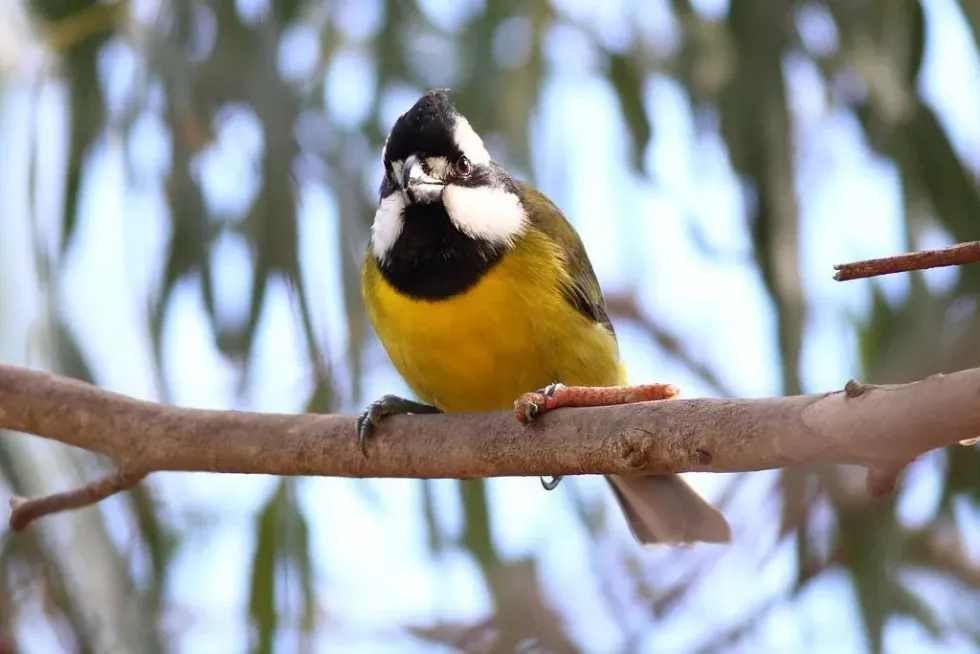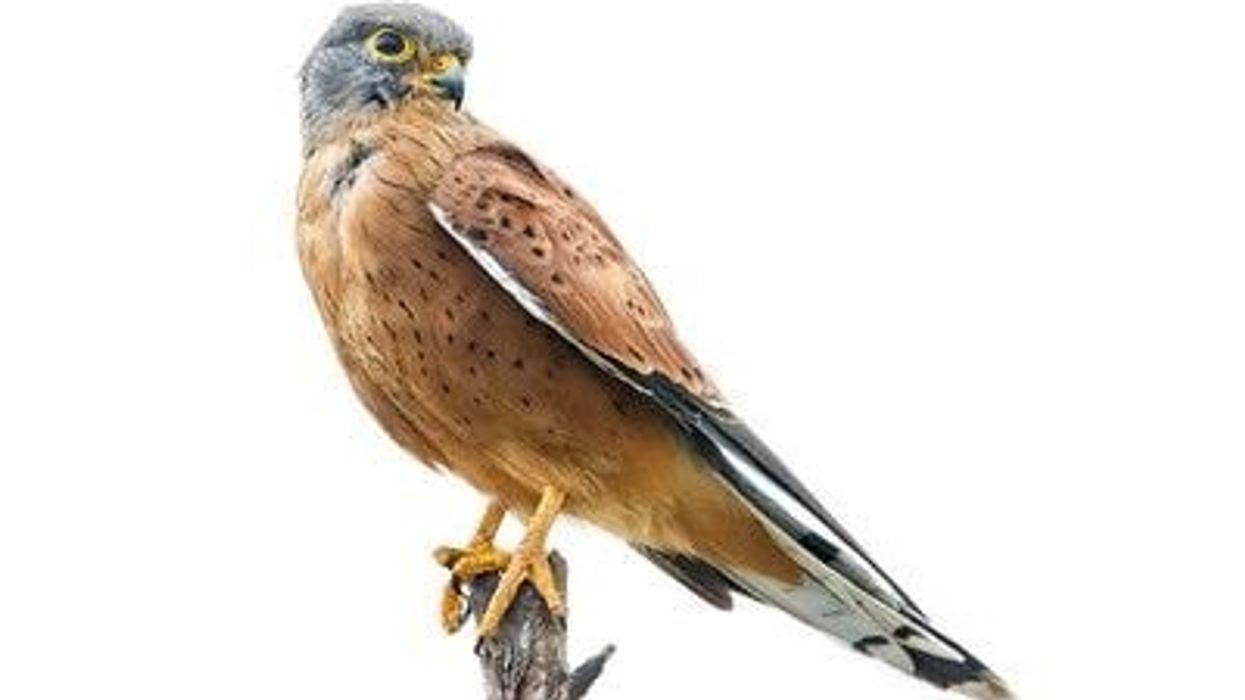In this article, we will learn about the fascinating bird, the crested shriketit (Falcunculus frontatus). This bird is endemic to Australia.
John Latham (1801) was the first ornithologist to provide a description of this bird. The crested shriketit's range map includes northern, western, and eastern Australia.
This species consists of three isolated subspecies - the Eastern Crested Shrike-tit (Falcunculus frontatus frontastus) which can be found throughout eastern Australia and its range extends to South Australia, the northern shriketit (Falcunculus frontatus whitei) is found in the Northern Territory, and the western shriketit (Falcunculus frontatus leucogaster) is found across southwest Western Australia.
The crested shriketit's appearance is bright and striking.
It has a white and black striped head and dark olive green to yellow-olive backs. This bird also has wide, rounded wings and a crest that is often held flattened over its broad, median striped crown.
The male bird is larger in size than the females. Young shriketits have a pale-colored throat and a brown back.
If you enjoy reading about birds, be sure to check out palm warbler facts and red-backed shrike facts.
Crested Shriketit Interesting Facts
What type of animal is a crested shriketit?
The crested shriketit (Falcunculus frontatus) is a type of bird.
What class of animal does a crested shriketit belong to?
The crested shriketit belongs to class Aves and order Passeriformes. Furthermore, it belongs to the Falcunculidae family and the genus Falcunculus.
How many crested shriketits are there in the world?
Currently, there are no population estimates to calculate the total population of crested shriketits.
Where does a crested shriketit live?
The crested shriketit and its subspecies are endemic to Australia. Their subspecies are geographically isolated.
The eastern shriketit (Falcunculus frontatus frontatus) can be found in Queensland, the Atherton region, and the southeastern part of the country. Northern shriketits (Falcunculus frontatus whitei) are found all over northern Australia in the Kimberley and the Northern Territory. The western shriketit (Falcunculus frontatus leucogaster) can be found in southwest Western Australia.
What is a crested shriketit's habitat?
Crested shriketits (Falcunculus frontatus) can be found in abundance in the woodlands and eucalypt forests of Australia. The crested shriketit's habitat can also be located in rainforests, forested gullies as well as areas along the river. At times, these sweet birds are also seen in farms, parks, and areas with scattered trees.
Who does the crested shriketit live with?
Crested shriketits usually prefer living and foraging alone. However, at times they can also forage in pairs or in groups of up to five birds. The crested shriketits are also spotted in mixed feeding flocks where they forage with other insect-feeding birds like the golden whistlers.
How long does a crested shriketit live?
The crested shriketit's lifespan is estimated to be approximately 11 years.
How do they reproduce?
The breeding season for the crested shriketit, Falcunculus frontatus, is during the months of August to January. The nesting site is selected by the crested shriketit male and is usually located in the vertical fork of the eucalypt tree.
The males try to attract the crested shriketit female by waving its wings and quivering. The shriketit female is responsible for lining the nests with fine strips of bark, grass fibers.
The exterior of the nest is covered with spider webs, moss. The breeding generally results in two broods. The incubation period of the crested shriketit egg can last anywhere between 18-20 days.
The shriketit male and female, both participate in the incubation. Once the crested shriketit baby hatches, the young birds remain with their parents until the next breeding season starts.
What is their conservation status?
The eastern shriketit (sub-species frontatus) has been given the status of Least Concern in the Red List of Threatened Species by the International Union for Conservation of Nature or the IUCN.
Crested Shriketit Fun Facts
What do crested shriketits look like?

The crested shriketit, as the name suggests, has a large crested head and a vibrant plumage. The bird's head and neck have distinct white and black stripes. They also have a short heavy bill.
This bird has a relatively small crest that is often held flattened over its distinct crown. Its vibrant black eye lines act as a contrast to its bright white cheek patches.
The males and the females both have strikingly vibrant features but the latter's head patterns are not as bold. The northern, eastern, and south-western Australia subspecies can be differentiated from each other by looking at the color of their backs. Young shriketits are paler in color and have a brown back.
How cute are they?
This medium-sized bird's bright, striking plumage, wide rounded wings, and cool mohawk-like crest make it look super cute.
How do they communicate?
Crested shriketits, Falcunculus frontatus, communicate with each other through a bird call that sounds like 'keep-keep-keep' which sounds similar to a descending three-part whistle. During the breeding season, the shriketit, especially the Northern shriketit, uses this song to form and maintain new pairs. Their bird call often mimics the songs of other species.
How big is a crested shriketit?
A crested shriketit (Falcunculus frontatus) is a medium-sized bird that has a length of about 6.7 in (17 cm). This is almost four times smaller than vulturine guineafowl.
How fast can a crested shriketit fly?
More research needs to be conducted to calculate the flying speed of the Shriketit bird. Hawks, such as white hawks, can dive at speeds of 150 mph (241 kph).
How much does a crested shriketit weigh?
A shriketit bird is small in size and extremely light in weight. It has a weight between the range of 0.95-1.16 oz (27-33 g).
What are the male and female names of the species?
There are no unique names to distinguish between the males and the females crested shriketits. The male shriketits, however, are larger in body mass and wing length. They also have a black throat in contrast to the olive green throat of the females.
What would you call a baby crested shriketit?
A baby crested shriketit (Falcunculus frontatus) can be referred to as a hatchling or a chick.
What do they eat?
The majority of the crested shriketit's diet consists of insects. This bird feeds mainly on insects like wasps, termites, and spiders that they can capture by peeling bark from large branches and extracting them before feeding.
This bird also puts its short heavy bill but strong to open up various galls of insects. Foraging mostly takes place in trees and rarely on the ground. The shrike-tits at times can also be found feeding on fruits and seeds.
Are they poisonous?
No, the crested shriketit (Falcunculus frontatus) is not poisonous.
Would they make a good pet?
Crested shriketits are not known to be petted. Keeping their conservation status in mind, these birds should not be kept in captivity.
Did you know...
Their distinctive call helps them in distinguishing between the subspecies at a particular location.
The Eastern crested shriketit male has vibrant yellow underparts, olive-green back whereas the male western shriketit has a white abdomen. Observing these slight color differences in the three subspecies can help in proper identification.
The crested shriketit is the only species that is part of the family Falcunculidae as well as the genus Falcunculus.
Do crested shriketits migrate?
These birds are mostly sedentary in nature. However, at times, crested shriketits migrate locally during the autumn and winter in Australia.
Are crested shriketits endangered?
The eastern subspecies have been given the status of Least Concern and their population is said to be stable. However, the northern and the western subspecies have been categorized as Endangered and Near Threatened respectively.
The population for both these subspecies is on the decline.
A short supply of food due to hot fires, urban development, and land clearing have been listed as some of the factors responsible for this decline. Assessing the impact of the forest fires, researching the total population size, and its habitat selection can help in understanding and conserving this special species endemic to Australia.
Here at Kidadl, we have carefully created lots of interesting family-friendly animal facts for everyone to discover! Learn more about some other birds from our umbrellabird facts and whiskered treeswift facts pages.
You can even occupy yourself at home by coloring in one of our free printable bird coloring pages.










